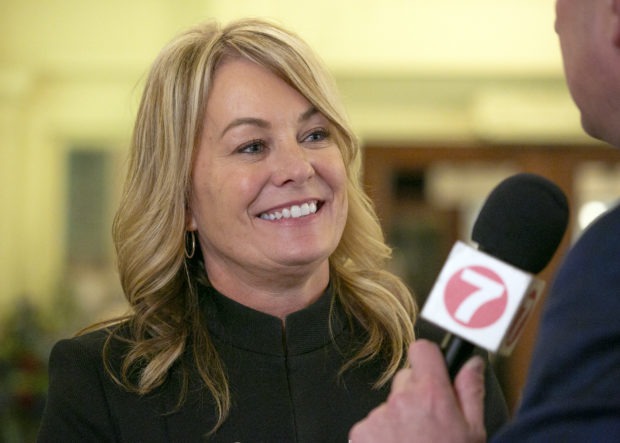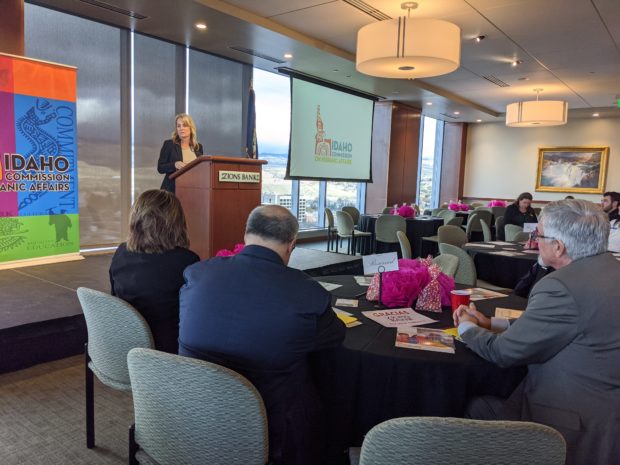
Idaho Schools Superintendent Emphasizes Importance Of Improved Outcomes For English Learners
BY SAMI EDGE / IdahoEdNews.org
Speaking to a room of educators, legislators and leaders in Idaho’s Hispanic community Thursday afternoon, Idaho Superintendent of Public Instruction Sherri Ybarra stressed the importance of improving outcomes for children learning English in Idaho’s schools.
The goal is not just professional, Ybarra said: It’s personal.
In her speech at the annual Idaho Commission on Hispanic Affairs legislative reception, Ybarra discussed marrying into a Hispanic family. Ybarra’s mother-in-law, she said, never received a high school diploma, largely because she struggled on English exams.
“My mother-in-law always says, ‘Mija, what are you doing? What are you doing to help us?’” Ybarra said.

Superintendent Sherri Ybarra speaks at the Idaho Commission on Hispanic Affairs legislative reception. CREDIT: Idaho Education News
Idaho’s schools have some 16,000 English language learners, and the majority speak Spanish as a primary language. Yet English language learners make up only 25 percent of Idaho’s Hispanic students, the vast majority of whom speak English.
“Many of our English language learners have unrealized academic potential,” Ybarra said. “And we must do more to support them.”Idaho’s schools have some 16,000 English language learners, and the majority speak Spanish as a primary language. Yet English language learners make up only 25 percent of Idaho’s Hispanic students, the vast majority of whom speak English.
In recent years, more English language learners have been reaching grade-level proficiency in math and English language arts, test data shows — but remain far behind other students.
- In 2019, only 19 percent of English language learners were proficient in English language arts, compared to 58 percent of native English speakers.
- In math, 16 percent of English language learners were considered proficient, compared to 47 percent of their peers.
“There is still a gap in our subgroups, in our populations of students. A big one. And we need to close that,” Ybarra said. “They’re making gains, just not fast enough.”
Education has long been a top priority for Idaho’s Commission on Hispanic Affairs, and it was the central theme Thursday.
In 2019, graduation rates declined for Hispanic and Latino students, dropping two percentage points to 73.9 percent. (The state average is 80.7 percent.)Shortly before Ybarra’s speech, Juan Alvarez — deputy director of the Idaho National Laboratory and the chairman of the Hispanic Commission’s board — emphasized the need to improve outcomes for all Hispanic children, who make up 18 percent of Idaho’s students.
- In 2016, only 13 percent of Idaho’s Hispanic adults held college degrees or certificates, compared to 41 percent of Idaho’s adults overall.
- In districts across the state, white students achieve proficiency in core subjects at far higher rates than their Hispanic peers.
“Although there are indications of improvement and there is much to be proud of … our work is far from done,” Alvarez said. “Too many Hispanic children in Idaho are still falling behind.”
For more coverage of Hispanic and Latino student outcomes in Idaho, read an ongoing series by Idaho EdNews and Idaho Statesman reporters Sami Edge and Nicole Foy.
Originally posted on IdahoEdNews.org on January 31, 2020
NOTE: Idaho Education News is an underwriter of NWPB programming, though NWPB is editorially independent. See all NWPB business supporters here. This article is re-published with permission.















